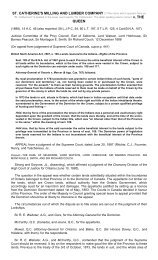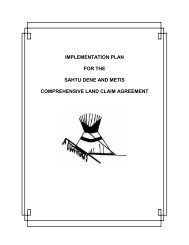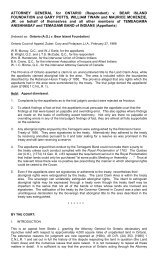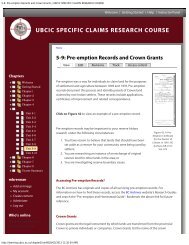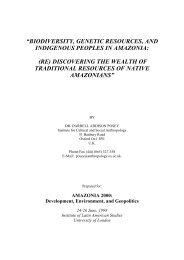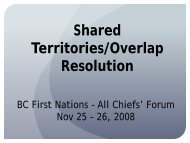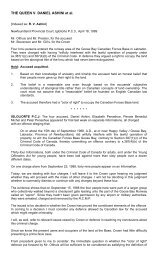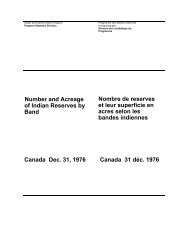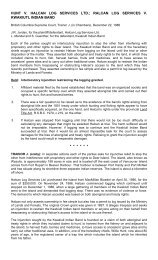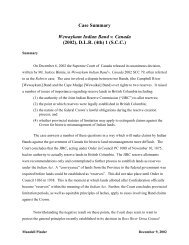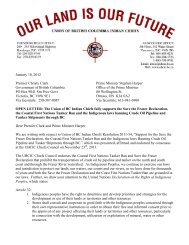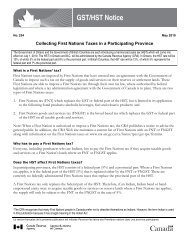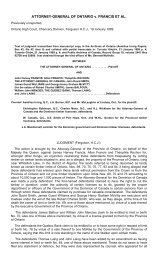Constitutional âPropertyâ and Reserve Creation: Seybold Revisited
Constitutional âPropertyâ and Reserve Creation: Seybold Revisited
Constitutional âPropertyâ and Reserve Creation: Seybold Revisited
You also want an ePaper? Increase the reach of your titles
YUMPU automatically turns print PDFs into web optimized ePapers that Google loves.
2 MANITOBA LAW JOURNAL VOL 32 NO 1This paper attempts to answer the question of whether the federal governmenthas the authority to settle agreements <strong>and</strong> meet treaty <strong>and</strong> other constitutionalobligations unilaterally with respect to the creation of “l<strong>and</strong>s reserved forthe Indians” under s. 91(24) of the Constitution Act 1867.In this paper I argue for a purposive reading of s. 109 in light of the indivisibilityof the Crown. Second, I argue against a proprietary approach to resolvingconflict between federal powers over Indian l<strong>and</strong>s <strong>and</strong> provincial s. 109 rights. 3 Iconclude that federal actions which regulate the use of public l<strong>and</strong>s “belonging”to the province under s. 109 are valid unless they are a colourable attempt to disposeof or derive revenue from public l<strong>and</strong>s, <strong>and</strong> so long as they manifest the “essenceof” federal jurisdiction under s. 91(24). This should mean that the federalgovernment can reserve public l<strong>and</strong>s for use by Indians, regardless of whether ornot they are s. 109 l<strong>and</strong>s of a province. It should also render provincial “confirmation”of reserves unnecessary.II. INDIVISIBILITY OF THE CROWNWithin Canada public l<strong>and</strong>s are vested in Her Majesty the Queen. The Crown isvested with public l<strong>and</strong>s <strong>and</strong> is indivisible for the purposes of l<strong>and</strong> ownership. 4One might complain that Canada is a sovereign nation <strong>and</strong> moreover, a federalone, <strong>and</strong> that therefore the Crown must be divisible. This is to miss the point ofCrown indivisibility, for it serves to unite the “sovereignties” of the respectiveprovinces <strong>and</strong> the federal government into one state, under one “sovereign.” 5The very idea that there are multiple sovereignties, that the provinces are notsubordinate to or delegates of the federal government, is based on the idea thatboth have a direct relationship to the single, indivisible Crown. 6 While theCrown in the United Kingdom is divisible from the Crown in the Dominions,this is merely a description of the political independence of the former colonies. 734567Kerry Wilkins, “Negative Capability: Of Provinces <strong>and</strong> L<strong>and</strong>s <strong>Reserve</strong>d for the Indians”(2002) 1 Indigenous L. J. 57 at 75.See Maurice Sunkin & Sebastian Payne, The Nature of the crown, a legal <strong>and</strong> political analysis(Oxford: Oxford University press, 1999) at 59-61.See the Royal Styles <strong>and</strong> Titles Act, R.S. 1985, c. R-12, s. 2.Maritime Bank of Canada (Liquidators of) v. Reciever-General of New Brunswick, [1892] A.C. 437at 441-442, [1892] J.C.J. no.1 (P.C.), [Martime Bank].Regina v. Secretary of State for Foreign <strong>and</strong> Commonwealth Affairs Ex. Parte Indian Association ofAlberta <strong>and</strong> Others, [1982] 1 Q.B. 892 (C.A.) at 916-917 (Denning M.R.). In a separate judgmentKerr L.J. at 919-926, felt that it is merely a territorial constraint on Crown liability.The discussion in this case <strong>and</strong> others regarding liability of the Crown is a separate issue –relating to which revenue fund the liability applies <strong>and</strong> as such is not really about the Crownbut the legislature.



